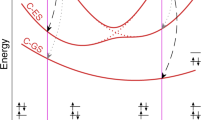Abstract
After reviewing the time dependent wavepacket method as applied to collision induced dissociation processes,we report accurate quantum results for reactive and non reactive collinear A+BC systems. Both systems display a vibrational enhancement effect in the low energy region. While the non reactive systems exhibit a vibrational inhibition effect at higher energies,a more complex behavior is observed in the reactive case. Below the classical dissociation threshold,the non reactive systems display tunnelling tails which decrease with the initial vibrational excitation of the diatomic molecule. The reactive system displays important quantum effects at energies well above the classical dissociation threshold.
Access this chapter
Tax calculation will be finalised at checkout
Purchases are for personal use only
Preview
Unable to display preview. Download preview PDF.
Similar content being viewed by others
References
L.W. Ford, D.J. Diestler and A.F. Wagner, J.Chem.Phys., 63(1975), 2019.
K.C. Kulander, J.Chem.Phys.,69 (1978),5064; J.C. Gray, G.A. Fraser, D.G. Truhlar and K.C. Kulander,J.Chem.Phys.,73 (1980),5726.
C. Leforestier, G. Bergeron and P. Hiberty, Chem.Phys.Letters,84(1981), 385; G. Bergeron, P. Hiberty and C. Leforestier,Chem.Phys.,93(1985),253.
C. Leforestier, Chem.Phys.,87 (1984),241.
G. Wolken, J.Chem.Phys.,63 (1975),528.
E.W. Knapp, D.J. Diestler and Y.W. Liu, Chem.Phys.Letters,49(1977),379.
E.W. Knapp and D.J. Diestler, J.Chem.Phys.,67(1977),4969.
L.H. Beard and D.A. Micha, J.Chem.Phys.,73(1980),1193.
G.D. Barg and A. Askar, Chem.Phys.Letters,76(1980),609.
J. Manz and J. Römelt, Chem.Phys.Letters,77(1981),172.
J.A. Kaye and A. Kuppermann, Chem.Phys.Letters,78 (1981),546.
M.I. Haftel and T.K. Lim, Chem.Phys.Letters,89(1982),31.
L.L. Johnson and R.E. Roberts, Chem.Phys.Letters,7 (1970),480.
I. Rusinek and R.E. Roberts, J.Chem.Phys.,65(1976),872; ibid.,68 (1978),1147.
I. Rusinek, J.Chem.Phys.,22(1980),4518.
J.D. Kelley and M. Wolfsberg, J.Chem.Phys.,53(1970),2967.
G. Bergeron and X. Chapuisat, Chem.Phys.Letters,11(1971),334.
E.A. Mc Cullough and R.E. Wyatt, J.Chem.Phys.,54(1971),3578.
P.J. Kuntz in:“Modern Theoretical Chemistry”,Vol.2,ed.W.H. Miller, Plenum Press, New York,1976.
J. Mazur and R.J. Rubin, J.Chem.Phys.,31(1959),1395.
S.A. Orszag, Studies Applied Math.,51 (1972),253;ibid.,50(1971),293; S.A. Orszag,Phys.Rev.Letters,26 (1971),1100; D.Gottlieb and S. Orszag,Numerical analysis of spectral methods, theory and application(SIAM,Philadelphia,1977)
D. Kosloff and R. Kosloff, J.Comp.Phys.,52(1983),35.
D.M. Young and R.T. Gregory,“A survey of numerical mathematics”, Addison-Wesley,Reading,1973.
A. Askar and A.S. Cakmak, J.Chem.Phys.,68(1978),2794; R.J. Rubin,J.Chem.Phys.,70 (1979),4811.
H. Tal-Ezer and R. Kosloff, J.Chem.Phys.,81(1984),3967.
P.M. Hunt and M.S. Child, J.Phys.Chem.,86(1982),1116.
P.M. Hunt and S. Sridharan, J.Chem.Phys.,77(1982),4022.
C. Leforestier, to be published.
S.C. Leasure and J.M. Bowman, Chem.Phys.Letters,39(1976),462.
G. Bergeron and C. Leforestier, Chem.Phys.Letters,71(1980),519.
G.A. Parker and R.T Pack, J.Chem.Phys.,68(1978),1585.
Author information
Authors and Affiliations
Editor information
Editors and Affiliations
Rights and permissions
Copyright information
© 1986 D. Reidel Publishing Company
About this chapter
Cite this chapter
Leforestier, C. (1986). The Time Dependent Wavepacket Method: Application to Collision Induced Dissociation Processes. In: Clary, D.C. (eds) The Theory of Chemical Reaction Dynamics. NATO ASI Series, vol 170. Springer, Dordrecht. https://doi.org/10.1007/978-94-009-4618-7_10
Download citation
DOI: https://doi.org/10.1007/978-94-009-4618-7_10
Publisher Name: Springer, Dordrecht
Print ISBN: 978-94-010-8552-6
Online ISBN: 978-94-009-4618-7
eBook Packages: Springer Book Archive




